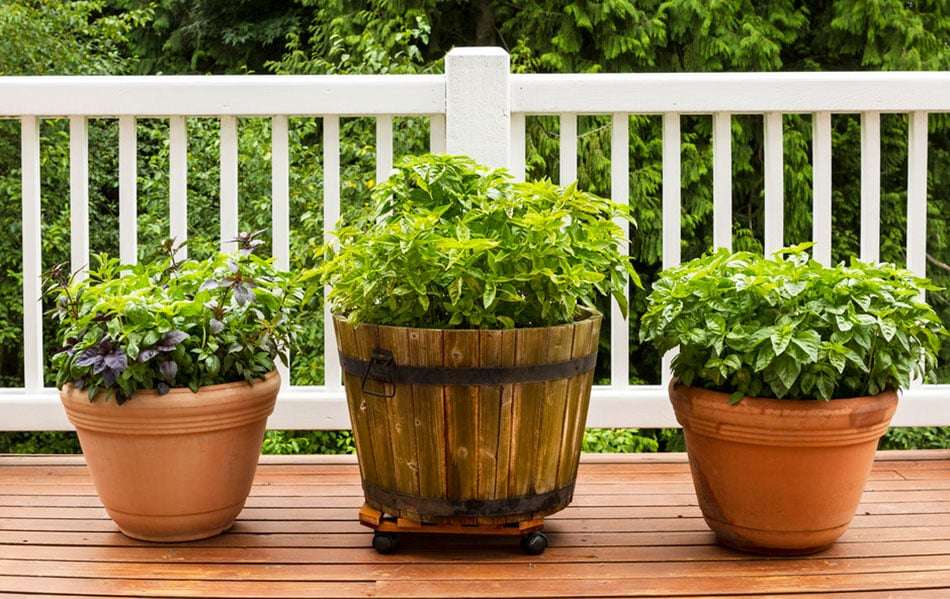Taking the time to grow your own vegetables is a wonderfully green way to cut down on your consumed air miles and ensure you are consuming organic, naturally grown veg that’s chemical-free. It’s a good way to save money too, especially if you grow vegetables that are typically more expensive to purchase in-store such as herbs, chilies, avocados, and kale.
You might think that you need a large garden with a dedicated vegetable patch in order to produce your own veg. However, that’s not the case at all! Balconies, patios, and windowsills all make great growing places.
Small spaces suitable for growing your own vegetables
Windowsills
Both inside and outside windowsill can be used to grow your own vegetables and herbs. Choose a window that gets lots of sunlight to help your plants to thrive.
If you’re placing the pots outside, ensure they are secured so that they won’t blow off if it gets windy – especially if the window isn’t on the ground floor! If there’s going to be a storm or particularly bad weather, consider moving the pots inside until it passes to protect your plants. Also, make sure that you won’t nudge the pots when opening or closing windows as this might dislodge them or knock them off the ledge.
Outside pots and containers
If your garden is too small for a dedicated vegetable patch, there are still ways in which you can grow your own vegetables. You can use pots and trellises to grow vegetables.
If you don’t have a garden at all, pots can be positioned outside on your front porch or around the edges of your driveway – just make sure they aren’t in danger of being hit when you park your car.
Here are some top tips for growing vegetables in pots (also known as ‘container gardening’):
- Most vegetable plants like lots of suns, so place them somewhere that they will get at least six hours of sunlight per day
- Choose a sheltered spot to protect from the wind
- On hot days, give your plants along the water in the early morning and late evening to stop them from drying out
- Make sure the pot has adequate draining holes as plants can die if the roots become waterlogged
- Help soil irrigation by placing small stones in the bottom of the pot before adding the soil
- Don’t fill pots with soil from your garden – instead, use potting soil or compost
- Replenish the soil each season as the nutrients will get used up
Balconies
If you’re lucky enough to have a balcony on your property, this gives you an excellent opportunity to grow your own vegetables. Use pots or install small bedding areas to make the most of the space. You can use the balcony railings as stabilizers for vertical plants such as beans.
Make sure all pots and growing areas are properly secured so that they don’t blow over (or away!) in strong winds.
The following video has some beautiful examples of balcony vegetable gardens to get your inspiration flowing!
Allotments
Okay, this option is cheating a little bit, but many people who don’t have a large garden of their own but dream of owning a vegetable patch opt to hire a patch at their local allotment.
Owning an allotment is hard work and it will require many hours of dedication. You’ll need to clear out the patch when you first get access to it to remove all weeds and traces of plants from the previous allotment holder. You may need to add natural, organic fertilizers to the soil if it has become void of natural nutrients due to the previous over-use.
You’ll need to draw up plans for your allotment every season to ensure you plant your vegetables at the correct time of year and that you always have a fresh supply of harvestable plants ready for eating.
Many allotments are inspected regularly to ensure you are keeping them tidy and weed-free. If you fail to keep your allotment up-to-scratch, you may be evicted from the patch.
Despite a large amount of effort, the rewards you get back from an allotment can make a real difference in your life. If you enjoy gardening (in all weathers!) and are looking for a new pastime to get you out of the house, exercising regularly, and meeting new people then an allotment might be just what you need.
Fancy starting your own allotment? Watch the video below for some top tips for allotment beginners.
Best vegetables to grow without a garden
Some vegetables will thrive in small spaces whereas others would be better suited for a vegetable patch or allotment. The following plants should all grow well in containers:
Herbs
Herbs are probably the easiest plant to grow in small spaces as they don’t need much room and they grow quickly. Most herbs are just as happy sat inside on a windowsill as they are outside.
Growing herbs is a great way to add flavor to your meals. Fresh herbs can be expensive to purchase in the supermarket and they are often packaged up with artificial chemicals that are designed to keep the herbs looking green and fresh in their plastic packages.
Maintaining your own herb garden will save you money over time and it’s a much more natural way to eat them.
Frozen herbs are perfect for adding to soups and other recipes to add instant flavor. You can even try making your own frozen herb butter or pesto which again is a great money-saving tip as these products can be expensive to purchase.
Vegetables
As vegetables come in so many shapes and sizes, it’s important to research how much growing space each one needs in order to grow effectively. For example, carrots need deeper soil and more space than salad leaves. So, whilst carrots might grow perfectly well in a container outside, you wouldn’t be able to grow them on your windowsill, unlike salad leaves which would be fine.
The following vegetables can all be grown in containers or small spaces:
- Avocado
- Beans
- Beets
- Carrots
- Chili peppers
- Cucumber
- Kale
- Lettuce and salad leaves
- Spinach
- Sprouts
- Some squashes
- Sweet peppers
- Zucchini
Fruit
It’s not all about the vegetables! Some species of fruit can also be grown in small spaces. In fact, growing fruit indoors opens up a whole new world of choice as you can grow some varieties that would not survive outside due to the climate being different to their natural countries of growth.
Tomatoes, dwarf oranges, grapefruit, tangerines, limes, pineapple, guava, strawberries, blueberries, and small melons can all be grown inside. Take your time researching each plant before you decide to grow it as some of them can grow quite large!
Do you grow your own vegetables without a garden?
Do you grow your own vegetables or fruit in a small space? Do you have an indoor herb garden to be proud of? Or perhaps you are struggling with a particular plant and need some advice from our readers? Leave your container gardening experience or tips in the comments below.

About the Author
James is your friendly neighborhood content writer here at the Green Living Blog. With a passion for all things sustainable, he’s your go-to guru for everything eco-friendly. Armed with a treasure trove of wisdom about sustainable living, recycling, and environmentally conscious practices, James is on a mission. He’s here to make sure you not only protect your family but also keep Mother Earth smiling. 😊🌎 When he’s not busy sharing eco-friendly insights, James can often be found teaching his cat that compost bins make the purr-fect hideaway. 🐱♻️ Join James on his quest to uncover the secrets of defeating wasteful habits while leaving the lightest footprint on our precious planet’s ecosystem.

